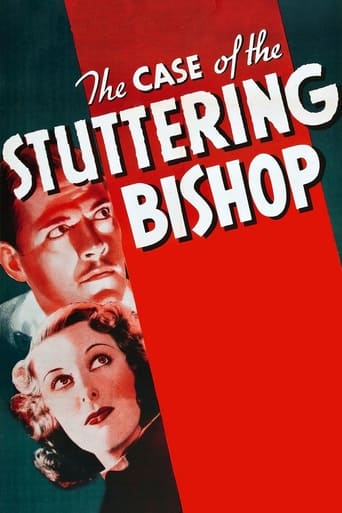utgard14
The sixth and final Perry Mason film from Warner Bros. once again features cast changes. Perry is now played by a mustachioed Donald Woods, a stiff leading man that I have never been particularly fond of. The guy has the charisma of wet socks. Perry's secretary Della Street is played this time by Ann Dvorak, an actress I actually do like a lot and think she could have been bigger than she was. She's the best part of this. Playing Perry's investigator Paul Drake this time is veteran character actor Joseph Crehan. The rest of the cast features familiar faces such as Anne Nagel, Frank Faylen, Tom Kennedy, and Veda Ann Borg.The plot this time has a Bishop (supposedly from Australia but you wouldn't know it by that accent) asking Perry to help an heiress. This is the least enjoyable of the WB Perry Mason movies. It is watchable but awfully dry and routine, not helped in the least by such an uncharismatic lead. Dvorak helps, as does Tom Kennedy as comic relief. But not enough to make this anything more than a middling B detective picture that's only worth seeing once.
Lynnlav
I missed the beginning of this movie. I enjoyed Perry Mason with Raymond Burr while growing up, so I was fan of enchanted to stumble upon this movie, which I also learned is part of a series that I will now look for. I watched this on TCM. Missing the beginning scenes might be why I was left confused & missed the point of the title. One really needs to pay close attention or you'll not be able to follow it very well & I sure missed something as I was left wondering where the real Janice was - or did the fake Janice also turn out to be the real one?But one thing I didn't miss was was a production goof in which the courtroom chairs & defendant's table are suddenly empty in the midst of Mason's cross of Brownings grandson! As the camera pans back & forth from Perry to the grandson, those chairs & table are filled with people, only to become empty, then fill up again! And that scene lasts for several seconds. Quite funny!
tedg
We had two great evolutionary paths in the 30s. One was an amazing diversity of invention to settle some basic narrative devices that have since served us well as the basic vocabulary of cinema. The other, parallel path was the pulp detective novel, a master of which was Gardner.The traditional, Holmes form is that you are linked to the detective. You discover what he does. Christie followed this form, but it is difficult to render in film. Gardner may be the first case — since common — of the novel adopting cinematic form. His formula does seem friendly to film: we see events that Mason does not, often before he gets seriously engaged. These events give us a false impression of what happened, so we as viewers start out with a deficit.Then we have the detection; Mason and company are detectives in act two. The third act is always a courtroom, which is why our detective has to be a lawyer. Courtroom conventions have their own evolution in film, and this instance is limited to what in Christie's stories has to be a contrived assembly of the suspects.This format allows for more complicated mysteries than were usual in film. My own preference for 30's detection is Philo Vance because the formula was not so strict. But this is a good one in terms of allowing complexity and surprise. We have that here in this solid instance.One of the decisions in defining the characters is how intimate to make the relationship between alpha male Mason and his pretty and competent secretary. Why this matters has to do, as Mason would say, with motive. We like the guy. He is smart, as smart as other detectives, but why he does what he does…In some renderings of the Mason format, he just likes to win. He has his own Lestrade who he likes humiliating. Justice is incidental, and truth merely a tactic. He just like to strut.In other renderings, he does what he does because he loves his team, his closest friend Drake and his lover Della. Both are profoundly loyal and true. He struts for her and we imagine passion after the obligatory Italian restaurant scene.Here, a delicate balance between the two is maintained.
Breck
As someone who has read all 82 of the Perry Mason novels, I have to say that this is the best I've seen of the Warner Brothers Perry Mason films. Readers of Gardner's mysteries will appreciate how faithfully the screen writers were able to keep to the essentials of the original plot in this short 70 minute film.This film is far superior to the turkeys WB made with Warren William (although that's not saying much.) And Donald Woods was more like the literary Mason than Raymond Burr, who was almost fat enough by the end of the TV series to play Nero Wolfe!And, of course, there's the great 1930's atmosphere in this film, something the TV series could never hope to reproduce.


